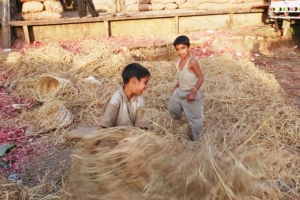10 Facts on Child Labor

Child labor is work that steals a child’s childhood. Defined in International Labour Organization (ILO) Conventions, child labor is work that children should not be involved in given their age, or – if that child is old enough – work that is too dangerous and unsuitable.
Forcing children to take part in often dangerous and strenuous work and preventing them from attending school, child labor stands in the way of a child’s healthy physical and mental development in addition to his or her education.
In some cases children are enslaved laborers, engaged in the agricultural, mining and manufacturing sectors, or in domestic service, subsequently pushed into homelessness and living on the streets. However, others are trafficked and enslaved in prostitution, or forced into armed combat as child soldiers. These are all forms of child labor; the latter qualifying as some of the worst forms of child labor given that such bondage is especially harmful and in direct violation of a child’s human rights. Child labor is a continuing global phenomenon and following are some shocking, but important, facts regarding the practice.
Important Facts about Child Labor
- Currently, there are nearly 30 million people held in slavery and an estimated 26 percent are children.
- In 2012, 168 million children – from 5-years-old to 17 – were involved in child labor. Of this number, 85 million worked in hazardous conditions, enduring beatings to sexual violence.
- Around the world one in six children are forced to work, with children below the age of 18 representing between 40 to 50 percent of laborers.
- Children living in more rural areas can begin working as young as the age of five.
- According to the ILO, an estimated two thirds of all child labor is in the agricultural sector.
- The highest proportion of child laborers is in Sub-Saharan Africa where 49 million children are forced laborers.
- The highest numbers of child laborers are in Asia and the Pacific, where over 122 million children are forced into work.
- According to the U.N. Children’s Fund (UNICEF), there are over 300,000 child soldiers forced into armed combat.
- In most regions, girls are just as likely as boys to be involved in child labor; however, girls are more likely to be involved in domestic work.
- According to the ILO, only one in five child laborers is paid for their work, as the majority of child laborers are unpaid family workers.
So why are some children forced into labor?
Poverty is the most often cited reason why children work. Pressured to provide food and shelter, as well as to pay off debt owed by the parents, some children have no other choice but to become involved in labor in order to support their families. However, some children are sold against their will and forced into slavery. Other factors that influence whether children work or not include barriers to education and inadequate enforcement of legislation protecting children.
Child labor is a complex issue, as are the solutions, but the following steps must continue to be pushed for in order to see further progress. First and foremost, child labor laws must be enforced. Another strategy would be to reduce poverty in these areas so as to limit the need for children to be forced into these situations. Finally, providing access to quality education ensures that each child has a chance for a better future.
– Rachel Cannon
Sources: UNICEF 1, International Justice Mission, UNICEF 2, International Programme on the Elimination of Child Labour, International Labour Organization, UN 1, UN 2
Photo: Flickr
